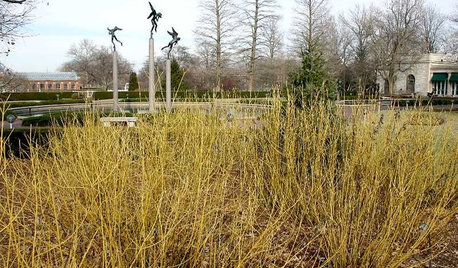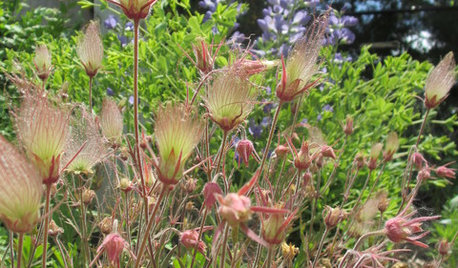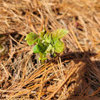Sterilizing seed starting medium?
Natures_Nature
10 years ago
Featured Answer
Sort by:Oldest
Comments (44)
digdirt2
10 years agolast modified: 9 years agoRelated Discussions
seed starting medium
Comments (6)Sterility and a high degree of aeration are generally considered two important properties of media to be used for starting seeds. Packaged seed starting mixes work well, (like Jiffy Mix) because they are sterilized, but they can be easy to over-water, so be careful if you use them. I have found that sterility doesn't seem to be as important as aeration increases, probably because any chance of anaerobic conditions are reduced in an inverse relationship with aeration, so damping off disease pathogens don't as easily get a foothold as they can in heavier mixes like potting soil. What I have used successfully: Jiffy Mix, 100% screened Turface, 100% perlite, the gritty mix, the 5:1:1 mix. For the pine seeds, I would suggest spreading them over a bed of screened Turface or the gritty mix in the fall. Cover them with 1/4" of Turface fines or coarse sand and let them over-winter in your garage. If the seeds are stratified, skip the overwintering part & plant in early spring. Since very high aeration levels are excellent for seed starting and seedling growth, it is often a benefit to cover the seeds with coarse sand or Turface fines to keep them from drying out on the media surface. Al...See MoreStarting from Seeds
Comments (14)in our green house we grew 30,000 seedlings this year. for potting soil we use Black Gold and petemoss. we give away 5/6 of our seedlings so we are non-profit. this means we do a lot of thins by hand and with volunteer labor. we have fun and we get all the seedlings we want for our gardens. what a deal. we put a large bag of Black gold and 1/3 of a large bail of pete in a large wheelbarrow with some kind of plant food. also a quart of pearlite. we then soak that mixture with water. one person turns the mixture with a shovel and the other put the water in. we make it real soggy. we put this mixture in propagation trays about 1/2" thick and put about 500 to 1000 seed spread around on the tray. we then cover the seed lightly with dry Black Gold and a piece of cotton cloth. like an old sheet cut to fit the tray. we then put the trays on our heating pads. not the kind you use to warm your feet at night in the winter. these pads are water proof and are about 18" x 4 feet. when the seen is germinated and the seedling is about 1" to 2" tall we then transplant them in to 4 and 6 packs. for most home gardeners this is way to much. so i will try to make the points you need to know. you can get sterilized potting soil that has plant food in it. you will need to soak it well. you can get six packs from your local garden supply store. you can put our seed right in to the six packs an avoid a step. cove with cotton cloth. put in a warm place. at least 80 degrees. remove the cloth when the seedlings poke their heads up. put in the full sun on a cookie sheet to catch the water that drains off the plants. water often. two or three time a day. set them outside when it is not freezing to harden them off about a week or two before you set them out in your garden. plant twice as many as you think you need. if they all come up share with family and friends. i don't think i have missed anything. that is a lot of work for plants you can buy for 50 cents but the up side is you get to grow what you want not what the nursery is offering. and the satisfaction of doing it all. my production is really getting into full swing now and i get to enjoy the fruits of my labor at least until i start put the food up. good luck WM...See MoreSprouting Dogwood seeds?!?!?
Comments (3)Time of year to collect seed: autumn Time of year to sow seed: autumn Seed treatment : stratify (give the seeds a period of moist chill) 40F for 3 months. Preferred temperature for germination : 70-85F Time required for germination : 14 weeks or longer If starting these indoors, use a sterile seed starting medium. Keep it moist but never soggy (about the same amount of moisture you would find if you had squeezed a wet sponge dry with your hand). If you are starting these and putting the pots outdoors, any commercial potting soil with good drainage will do....See MoreMy fenugreek seeds have germinated.
Comments (16)I have seed of fenugreek from 1997 and mung beans, probably the same age, from when I ate sprouts as a semi-vegetarian. I bought a special plastic sprouter for the purpose. Now that I am retired I started doing sprouting again because sprouts are nourishing and good to eat. Seeds for sprouting have become very expensive here so I decided to grow my own. To my surprise almost all the fenugreek and mung beans sprouted. I planted a mung bean in a large pot when it started to sprout and took 2 fenugreek seedlings just after they started to sprout and planted them too. The mung bean is thick and strong in my window facing south. Unfortunately I did not know fenugreek would grow as tall as a metre or more so they are in the small pots I use for presowing seeds and rather thin. Although I have read that fenugreek does not like to be transplanted I have moved 1 to a larger pot. How wide should the pot be? On recommendation by Swedish and Finnish gardening experts I fertilize all my house and garden plants (including orchids) with my own urine diluted with the correct amount of urine except the ones that shun calcium which I fertilize with coffee grounds (for example my blue hydrangea which I do not want to turn pink), and my geraniums (pelargoniums actually) which need low-nitrogen fertilizer and for which I do not know how to make a natural fertilizer yet. Can anyone tell me if urine is a good fertilizer for fenugreek or does it have too much nitrogen? Perhaps coffee grounds would be better as they prefer slightly acidic soil. I wonder if urine diluted with 30 or 40 parts water is low in nitrogen or if the diluting makes no effect on the quantity of nitrogen. I have never had any success with pelargoniums and they are not doing well this year either. Thank you for any help you can give me....See MoreNatures_Nature
10 years agolast modified: 9 years agoNatures_Nature
10 years agolast modified: 9 years agoseysonn
10 years agolast modified: 9 years agoplanatus
10 years agolast modified: 9 years agoseysonn
10 years agolast modified: 9 years agotheforgottenone1013 (SE MI zone 5b/6a)
10 years agolast modified: 9 years agodigdirt2
10 years agolast modified: 9 years agoNatures_Nature
10 years agolast modified: 9 years agoNatures_Nature
10 years agolast modified: 9 years agoNatures_Nature
10 years agolast modified: 9 years agoNatures_Nature
10 years agolast modified: 9 years agofusion_power
10 years agolast modified: 9 years agoNatures_Nature
10 years agolast modified: 9 years agoNatures_Nature
10 years agolast modified: 9 years agoNatures_Nature
10 years agolast modified: 9 years agowayne_5 zone 6a Central Indiana
10 years agolast modified: 9 years agoMadHacktress
10 years agolast modified: 9 years agodigdirt2
10 years agolast modified: 9 years agoNatures_Nature
10 years agolast modified: 9 years agoNatures_Nature
10 years agolast modified: 9 years agotheforgottenone1013 (SE MI zone 5b/6a)
10 years agolast modified: 9 years agoNatures_Nature
10 years agolast modified: 9 years agotheforgottenone1013 (SE MI zone 5b/6a)
10 years agolast modified: 9 years agoUser
10 years agolast modified: 9 years agoNatures_Nature
10 years agolast modified: 9 years agoMadHacktress
10 years agolast modified: 9 years agoNatures_Nature
10 years agolast modified: 9 years agofusion_power
10 years agolast modified: 9 years agodigdirt2
10 years agolast modified: 9 years agoNatures_Nature
10 years agolast modified: 9 years agodigdirt2
10 years agolast modified: 9 years agoplanatus
10 years agolast modified: 9 years agoseysonn
10 years agolast modified: 9 years agozeedman Zone 5 Wisconsin
10 years agolast modified: 9 years agodaninthedirt (USDA 9a, HZ9, CentTX, Sunset z30, Cfa)
10 years agolast modified: 9 years agowayne_5 zone 6a Central Indiana
10 years agolast modified: 9 years agodaninthedirt (USDA 9a, HZ9, CentTX, Sunset z30, Cfa)
10 years agolast modified: 9 years agoOhiofem 6a/5b Southwest Ohio
10 years agolast modified: 9 years agodaninthedirt (USDA 9a, HZ9, CentTX, Sunset z30, Cfa)
10 years agolast modified: 9 years agolittle_minnie
10 years agolast modified: 9 years agodaninthedirt (USDA 9a, HZ9, CentTX, Sunset z30, Cfa)
10 years agolast modified: 9 years agoCreek-side
10 years agolast modified: 9 years ago
Related Stories

CONTAINER GARDENS8 Easy Container Plants to Grow From Seed
Get beautiful blooms and herbs in summer by starting these choice garden picks from seed in spring
Full Story
HOUSEPLANTSHow to Grow Orchids Indoors
Orchids are the exotic aristocrats of the flower world and can make themselves comfortable in almost any home
Full Story
GARDENING GUIDESHow to Stop Worrying and Start Loving Clay Soil
Clay has many more benefits than you might imagine
Full Story
FARM YOUR YARD6 Things to Know Before You Start Growing Your Own Food
It takes time and practice, but growing edibles in the suburbs or city is possible with smart prep and patience
Full Story
GARDENING AND LANDSCAPINGCitrus 101: Start Your Own Backyard Orchard
This Earth Day Weekend, Add Some Green, Style and Deliciousness to Your Landscape
Full Story
BATHROOM DESIGNNew This Week: 3 Bathrooms That Feel More Like Living Spaces
Graphic wallpaper, ornate chandeliers and furniture-like pieces help these bathrooms seem less like a sterile space and a lot more like home
Full Story
WINTER GARDENINGExtend Your Growing Season With a Cold Frame in the Garden
If the sun's shining, it might be time to sow seeds under glass to transplant or harvest
Full Story
CENTRAL PLAINS GARDENINGCentral Plains Gardener's January Checklist
Sow your garden dreams while poring over seed and plant catalogs and maybe getting crafty in the shed
Full Story
KITCHEN DESIGNChoose Your Kitchen Cabinet Glass
Textured? Frosted? Seeded? Find the cabinet glass style that will set off your kitchen to its best advantage
Full Story
GARDENING GUIDESGreat Design Plant: Geum Triflorum
Nodding red blooms, glittery effervescent seed heads and a tough-as-nails constitution make prairie smoke a winning ground cover
Full Story



User